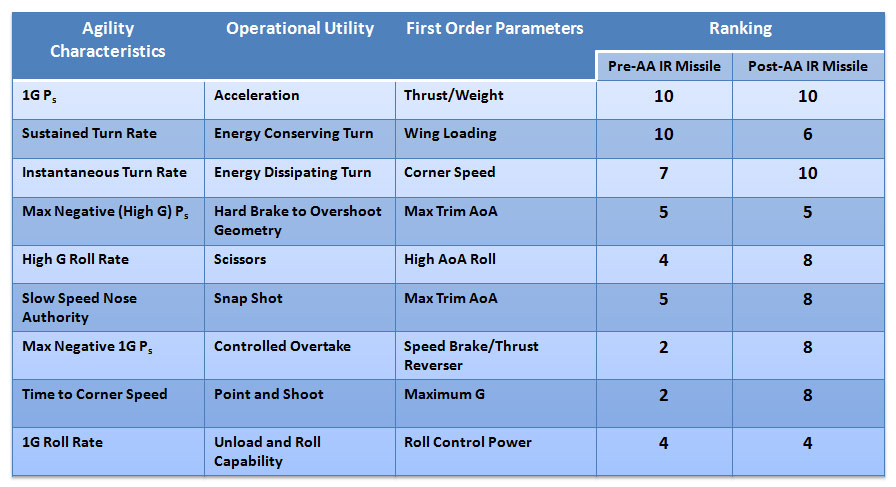How Would You "Score" Maneuverability Requirements Today? Part 1
Since maneuverability is a hot topic these days (especially here)....As I noted in a post ages ago, in the 1980's Skow, Hamilton and Taylor (Ref 1) observed:
“In the late 1940's and early 1950’s, with the advent of jet propulsion, radical new wing designs and greatly expanded flight envelopes, a corresponding need for more definitive measures of merit for aircraft performance comparisons was generated. When the "century series" fighters were developed and rear-aspect IR missiles became the principal air-to-air combat weapon, point performance comparisons were found to be inconclusive and insufficient to predict superiority. Out of this need, energy-maneuverability (E-M) concepts were formulated and developed. In the 1960's. E-M came into widespread use by aircraft designers and fighter pilots. E-M provided an analog picture of a fighter's performance capabilities over a range of velocities and altitudes. It gave quantifiable credit to measures of merit which allowed the advantages of speed (energy) and turning (maneuverability) to be balanced. These measures of merit were shown to be dominant in determining the outcome of an air battle at that time.
...
But, as they say, time marches on, and in the past 10-12 years, several significant advancements have been made in the capabilities of fighter aircraft and air-to-air weapons. Three of these advancements; the all-aspect IR missile, greatly improved weapons delivery systems, and high thrust-to-weight engines have dramatically altered the character of the air battle, especially the close-in fight. The modern air battle is characterized by (1) time compression – shorter duration maneuvering required and (2) harder maneuvering - nose position at the expense of energy vs. nose position with energy conservation…
Air combat trends have expanded to ever increasing altitudes and speeds for beyond visual range (BVR) combat and conversely have tended to a lower and sometimes slower arena for close-in, within visual range (WVR) combat. … …This changing complexion of air combat, primarily due to the all-aspect IR missile, has altered the relative significance of the various performance characteristics with which we judge relative merit. Table 3 depicts the more common agility characteristics with some relative rankings.”Time does march on, and so fighter and threat technology have progressed since 1985. So....
What About Today?
Regular readers will recognize this table from that earlier post:
 |
| 'Table 3' Reconstruction from “Advanced Fighter Agility Metrics”
|
As I see it, this would be a two part mental exercise. First we need to add columns on the right side of the table identifying any 'game-changing' developments that would cause further changes to the rankings shown. Stealth is an obvious development, but are there others like "very-high off-boresight missiles".
Before I put too much grey matter onto the project, I thought I'd open the floor for ideas, and then decide (collectively if there is interest) first what order and perhaps grouping the header(s) should be populated from left to right. I THINK the columns should be added in order of chronological developments, but I don't KNOW yet: I try to keep an open mind until info is in hand.
The end product of Phase 1/Question 1 would be the jumping off point for exploration of how these developments may change the relative rank ordering. I think I'm going to solicit inputs from F-16.net board members in a thread of its own, but I would welcome an even wider range of inputs and insights.
Survey Question 1:
What has changed since 1985 that would affect the rank ordering scores that each 'Agility Characteristic' (as the term is used in the table) would receive?
Reference:
ADVANCED FIGHTER AGILITY METRICS; Andrew M. Skow, William L. Hamilton, John H. Taylor; AIAA-A85-47027
No comments:
Post a Comment